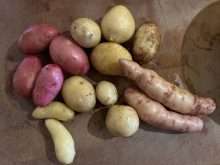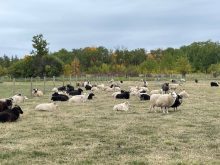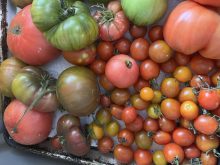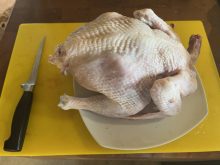It’s been cold in Saskatchewan lately. Yes, I know that’s a given in winter, but I mean cold, a solid month of lows in the -30s. The cold weather’s curtailed our “Gee, let’s just run to town for this or that” in a big way, and has me looking at my pantry with appreciation: all those chickens and sauces and stocks and preserves and frozen packets of joy I put into the freezer and onto the shelves last summer and fall. I always have enough food in the house to get us through a couple of months, and this winter we’ve been glad of that depth. It’s meant I can go to the freezer and pull out a meal or makings. That’s reassuring, especially in a time of upheaval and national anxiety: food and cooking remain lynchpins of how we care for ourselves and each other.
I’ve been writing about eating local, and the vital importance of home cooking, for decades. The eruption of trade wars and tariffs has me looking harder than ever at what we eat and where it comes from, like every other Canadian. In marmalade-making season, I’m looking for citrus from Europe, Mexico and the Middle East instead of our neighbour to the south, and as other fruits slowly price themselves into the winter stratosphere, I am careful to choose B.C. apples and pears over those from Washington.
But those are surface solutions. The bigger problem is that we have learned to expect a bursting pantry year-round, and our globally-based economy’s cracks and fissures have become glaringly evident. And while it’s true that while Canada grows and exports mustard, canola, soybeans, lentils, beef and pork, oats and wheat, Canada is a net importer of produce: our climate and geography dictate that we can’t grow enough fruits and vegetables to feed ourselves. In recent years we have witnessed huge disruptions to our culinary supply chain: the pandemic, global shifts in weather, and most recently, turmoil due to U.S. President Trump’s threats of trade tariffs. How do we shift to producing more of what we eat, and ensuring it reaches Canadian tables?
Read Also

Gentle treatments for pain in the neck
Heading toward year-end, people unknowingly tense up against the cold and busyness, causing neck pain that can often be treated with appropriate support and gentle mobility, athletic therapist Kathlyn Hossack says.
Eliminating interprovincial trade barriers is one necessity, as is active support of local food initiatives: home and community gardens, community-supported fisheries and farms, Seedy Saturdays, farmers’ markets and farm-direct sourcing, specialist farms, greenhouses, hydroponics, agri-tourism, urban gardens and farms, farmgate sales, festivals and suppers. These practices all keep Canadian money in Canadian hands. So support our farmers. Read those labels. Order your seeds. Plan your garden. In the meantime, first we eat, but after we read the label and buy Canadian.

Herb and apple biscuits
Looking for something seasonal to serve with my succession of wintry soups and stews, I turned to the tender currant scones I ate in every town I drove through in Ireland years ago. In this version, you may wish to substitute grated apple for some of the butter. The dried Canadian cranberries are tart and festive, an alternative to imported currants.
Makes 12.
- 2 c. all-purpose flour
- 1/2 tsp. kosher salt
- 6 Tbsp. golden brown sugar
- 1 Tbsp. baking powder
- the zest of 1 lime
- 2 Tbsp. chopped dried cranberries
- 2 tsp. minced fresh rosemary
- ½ c. unsalted butter
- 2/3 c. tart grated apple
- 1/2 c. buttermilk
How to bake
Set oven at 375 F. Line a baking sheet with parchment paper. On the counter, combine the dry ingredients, then stir in the zest, cranberries and rosemary. Add the butter and grated apple, and work in with your fingers until mealy in texture.
Add the buttermilk, and blend by lightly tossing the dry ingredients up with stiffly extended fingers, using your hands like two large salad forks. The dough will begin to come together into blobs.
Pack it all together into a ball, flatten it out with a minimum of handling, and form into a circle about 1 inch thick and roughly 10-12 inches in diameter. Cut out with a lightly floured fluted 2-inch round cutter, or cut into diamonds or triangles to avoid reworking the dough. Arrange on the baking sheet, fairly closely together. These biscuits rise up, not out, so ½-inch clearance is fine.
Bake in a preheated oven for about 20 minutes, turning end for end at the halfway point to ensure even baking. Serve warm or at room temperature.
















